This post about Solar energy systems is going a little outside of my normal “IT” theme of this site, but it’s very technical so I thought I would share. I’ve been doing a ton of research about going solar found all of the technical details fascinating, as well as confusing at times. So here’s a “brain dump” of what all I’ve learned about solar from a residential consumer perspective. Hopefully it will be of use to people that are very technical and thinking about going solar. I apologize for the length, but this topic is complicated and deserves solid coverage.
Why Solar?
I won’t spend of ton of time on this topic, as everyone is familiar with the “green” and “renewable” nature of solar energy. Basically you throw up some panels on your roof (or ground mounted), aim them at the sun, and the photovoltaic cells convert the sun’s energy into DC (direct current) power. The larger and more efficient the solar panel, the more energy it will make. An inverter will then convert the DC energy into AC power than you can feed into the power grid and use in your home, or sell back to the utility. In SoCal, where I’m located, electric rates are exceptionally high so going solar can really be financially worthwhile. If you live in an area with cheap electricity and not so many sunny days, solar might not make any sense unless you do it purely to be “green” or want to semi-independent from the utility grid.
Solar System Components
A typical solar system will be comprised of the following basic components:
- Solar Panels
- DC to AC power inverter(s)
- Monitoring system
- (Optional) Energy Storage (batteries)
- Contractor/Installer
Solar Panels
Solar Panels can be one of the most confusing and overwhelming aspects of researching solar. There’s a lot of technical jargon, different vendors, warranties, etc. My requirements for solar panels were: high performance, iron clad warranty, and backed by an extremely well established company that “should” be around for the length of the warranty.
Let’s get to the meat of the solar panel specs, which include:
- Efficiency
- Physical size
- Temperature coefficient
- Performance Guarantee
- “AC” panels
- Bypass Diodes
- Bi-facial panels
- Warranty
Efficiency
Efficiency is the percentage of solar energy that is converted into DC power. Unfortunately, even in 2019, solar panels are not very efficient. The very top residential panels are about 22-23% efficient, whereas lower tier panels can dip down to 15 percent. Efficiency is key if the physical location you will be placing the panels is limited. For example, if you have one panel that is 14% efficient and another that is 21%, the 21% panel will give you 50% more kWh (kilowatt hours) under the same conditions and in the same physical space. That’s a big difference over the 20+ year working life of the panels.
Lower efficiency panels are cheaper, but you need more of them to achieve the same power output. So don’t automatically think “I need the highest efficiency panel out there” unless you are working with very limited roof (or ground) space. You WILL be paying for the extra efficiency, as the most efficient panels are also the most premium.
In terms of efficiency, in general the top panels are:
- SunPower – 22.8%
- LG – 21.7%
- REC Solar – 21.7%
- Panasonic – 20.3%
Physical Size
At first you may not give much thought to the physical size of solar panels, or think that all panels are the same size. Well all panels are NOT the same size, and your roof configuration may actually limit what size of panel you can use. If you have a large flat roof, then panel size may not make much of difference for you. But if your roof has lots of hips, multi-level, or otherwise have a complex topology, panel size is an important factor to consider. You may not be able to install “giant” SunPower 425w panels, and have to drop down to lower watt (smaller) panels.
For example, the SunPower A-series 425w residential AC module are the highest wattage panel you can easily buy for the residential market. However, they don’t have magic technology that makes them wildly more efficient than lower rated panels from SunPower or other vendors. They are equally efficient, but just physically larger (42″ x 72″ vs. 42″ x 61″ for the X series) and thus can produce more kWh. I’ve been told for SunPower that the cost per watt for the X series and A series is basically the same. So if you aren’t constrained by roof space, probably going with fewer large panels would be preferred over more lower wattage panels. Why? Less inverters (covered below) fewer panels to install and maintain.
Finding a good contractor that you trust is your key to finding the optimal panel size. They can look at overhead imagery of your residence and “virtually” place panels and give you an idea of what is the best fit for your application. Don’t always assume the “biggest baddest” panel is right for your house. More about panel placement below.
Temperature Coefficient of Power
Temperature coefficient of power is one of those super “nerdy” panel specs that while important to know about, but how important it is to you depends on your climate. What is a panel temperature power coefficient? Well when a panel is rated for power, it’s under certain test conditions (STC = Standard Test Conditions) including temperature (generally 77F/25C). If the panel is significantly hotter than the test condition, the power output will be reduced anywhere from 5-25%. How much reduction in power you see is related to the temperature coefficient of power. It is expressed as % power / degree C.
For example, let’s look at SunPower and Panasonic. SunPower’s rating is -.29% per 1 degree Celsius, whereas Panasonic -.258. This means Panasonic will lose a tiny bit less lower at varying temperatures over the Sunpower panel. At 20C over the rated test conditions, SunPower loses 5.8% of their output whereas Panasonic loses 5.16%. If you look at the QCells QPeak Duo 315, it has a temperature coefficient of -.37. Meaning, it would lose 7.4% for the same 20C increase.
Even if you don’t live in the desert with sustained high temps for a good part of the year, I would pay close attention to this attribute. Generally your top tier panels (SunPower, LG, Panasonic) all have excellent temperature performance. Even in SoCal where we have a moderate climate, temps up on the roof on the hottest days can get 20-30 degrees hotter than on the ground. So on those days you WILL see an output drop, even though you might think “Wow so much sunshine today my system should be cranking out the power.”
Below is a graph from LG which shows the decline in power output as the panel temperature increases.
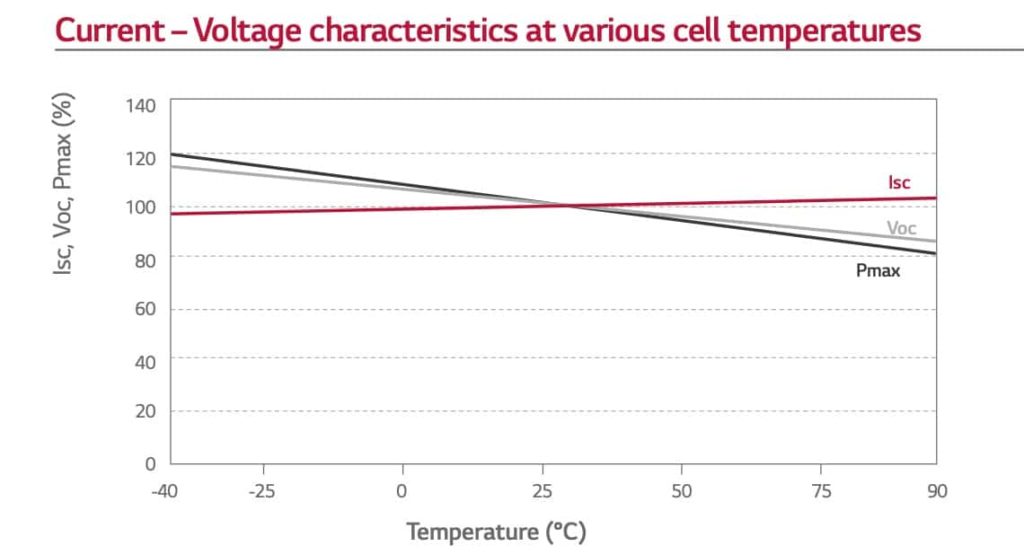
Performance Guarantee
One very important, IMHO, panel spec is the performance guarantee. What is a performance guarantee? Well just like most everything in life, performance of a solar panel WILL degrade over time. Over 25 years the output power performance can degrade by a startling amount. This degradation starts in year one and continues throughout the life of the panel. The biggest drop is in year one.
Top tier panels, such as SunPower and Panasonic, can degrade significantly less over 25 years than cheaper commodity panels. The list below shows the panel rating after 25 years. For example, SunPower will only lose up to 8% of the rated power output over 25 years, whereas Solaria loses nearly double that at 14%. Over the life of a panel that is A LOT Of lost power. So I would really look closely at the performance guarantee of a panel and place a lot of weight on this spec. The industry best is SunPower, followed by Panasonic.
- SunPower – 92%
- Panasonic – 90.76%
- LG – 87.6%
- Solaria – 86%
- Commodity panels- 81%
For a very detailed write up on solar panel warranties, see this article at Ecomensolar.com.
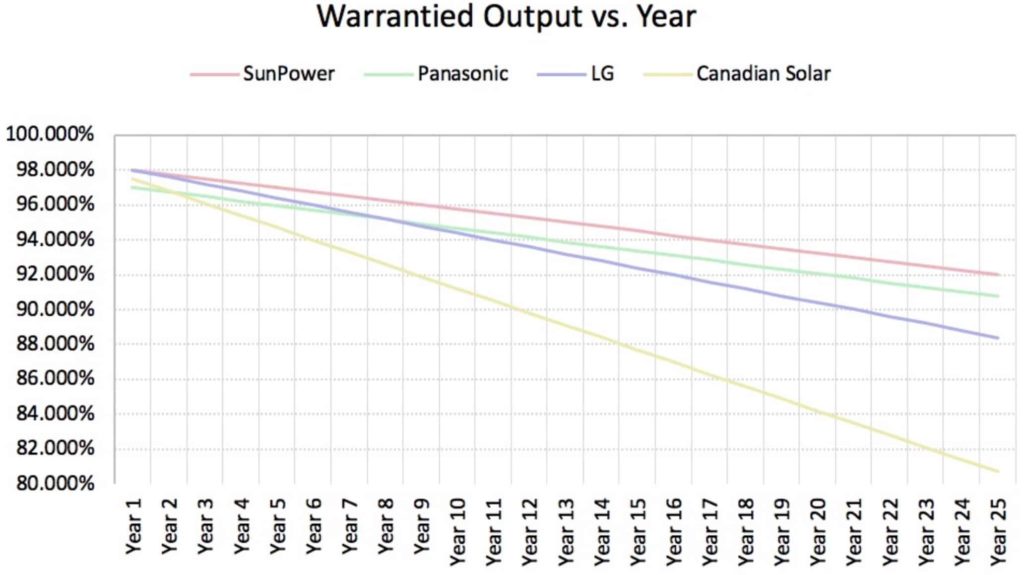
Solar "AC" Panels
Some manufacturers, such as Panasonic, LG and SunPower, sell “AC” panels. These panels are in fact just regular “DC” panels with a factory integrated microinverters from Enphase. I’m a fan of “AC” panels because the panel manufacturer is then covering the microinverter with the same warranty as the panel, which generally includes labor. Enphase seems to be a bit more stingy with labor coverage over the 25 years, so I felt more comfortable getting “AC” panels where the warranty was by the panel manufacturer that covered both materials and labor for the 25 years.
Bypass Diodes
Bypass diodes are used to reduce power loss due to panel shading. Theoretically the more diodes the less power loss due to partial shading of the panel. How do they work? Basically they compartmentalize a certain number of cells on a panel (typically 20), so if some cells are shaded it does not drag down the output of the other strings in the panel. Typical solar panels have 3 such diodes (like LG and SunPower), but Panasonic has 4. Here’s a great PDF from SolarEdge on bypass diodes, if you want a real deep dive.
Bi-Facial Cells
A couple of years ago manufacturers, such as Panasonic and LG started marking “bi-facial” panels. What is a bi-facial panel? Well it’s a panel that can turn both direct solar energy into DC power, as well as the light that is reflected onto the back of the cell. This means the solar panel can turn more ambient sunlight into power than for panels where just the top is “active”. This probably more applicable to ground mount panels with more reflected light, but may help slightly on traditional darker roof mount systems too.
You can check out more detailed information from LG here.
Solar Panel Warranty
Simply put, the best panel warranty in the industry is 25 years and it should cover: manufacturing defects, output performance, and labor. Most, if not all, of the top tier manufactures such as SunPower, Panasonic and LG offer 25 year panel warranties. Frankly, don’t settle for anything less than 25 years. If you see panels with less than 25 years, they are probably cheap imports that have other equally poor technical specs that you should steer away from. Panasonic calls their warranty (via authorized installers) the Triple Guard warranty. That’s just some fancy marketing, but don’t get me wrong, is a very comprehensive warranty.
Solar Panel Placement
One key factor in determining how many panels you can plan on the roof are your local or state fire codes. You can’t just throw panels up on the roof whilly nilly anywhere you like. This is where a trusted contractor should know the fire rules and keep panels out of the prohibited areas on your roof. The photo below is an example of shaded areas where a particular contractor was not willing to put panels due to fire codes. Pro tip: Make sure your contractor comes out and physically measures your roof and precisely follows the local fire code. This may limit the total number of panels you can install. Your HOA and city inspector will likely care as well.
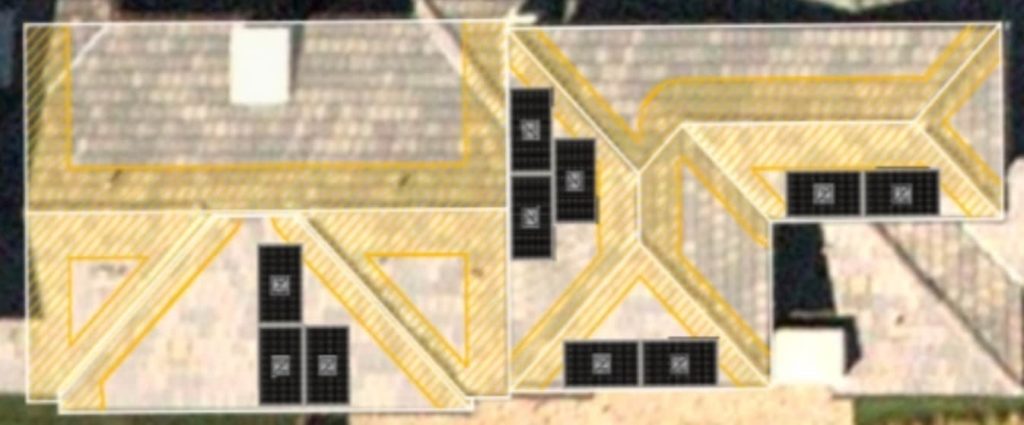
"AC" Solar Panel Comparison
Below is a chart, current as of December 2019, of the top-end LG, Panasonic and SunPower solar panels. These are the “AC” versions, with the integrated Enphase microconverters. Note that some LG panels are bi-facial, but not all are.
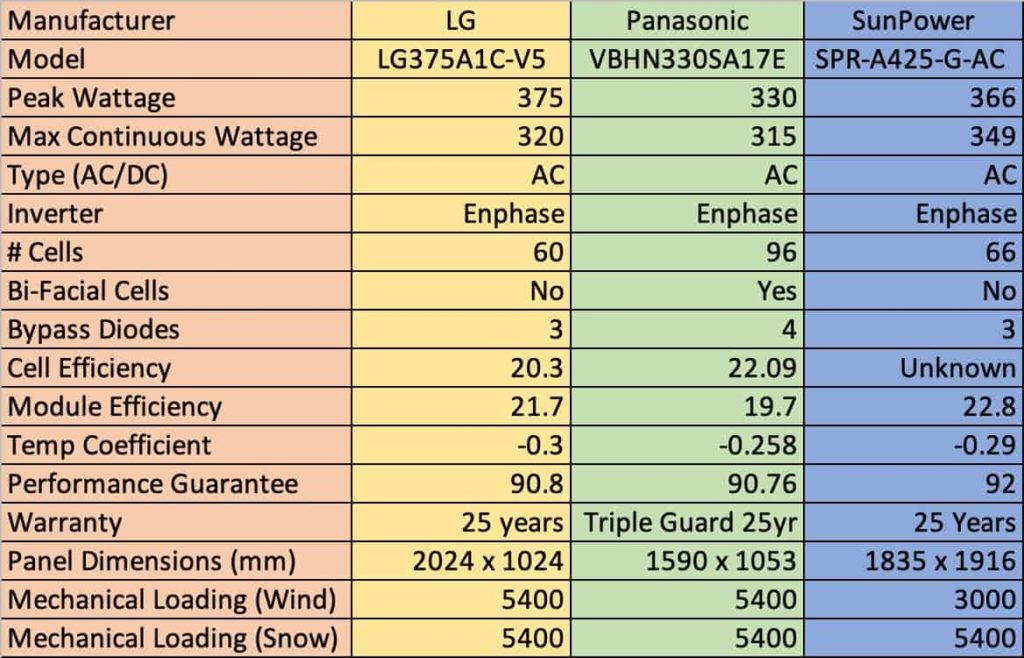
Solar Power Inverters
If you haven’t already picked up on it from earlier sections, solar panels produce DC (direct current) power. However, your house and the grid run off AC (alternating current). Your solar system needs a way to convert DC to AC power, and the device that does this is called an inverter. Inverters can be a bit controversial topic, as contractors may be beholden to one brand or another for various reasons. There are three different architectures for inverters:
- String
- Micro-inverter
- DC-optimizer + inverter

Here is his part two video that explains the situation further. Great info! TL;DR: Go with Enphase!
As for Enphase microinverter reliability, I found this video on YouTube from the biggest Australian solar installer. They have over 100,000 Enphase microinverters installed and have had literally only 6 fail in the field. That’s statistically insignificant amount. They also have a full blog post write up on Enphase reliability that you can read here.
Solar System Monitoring
One of the key aspects of a solar system for ‘nerds’ is detailed monitoring. There are two major types of monitoring for solar systems: panel level and system level. They are exactly what they sound like. Panel level monitoring, that you get from from vendors like Enphase and SolarEdge, give you detailed production for each panel in your system. If you get bird poop or leaves on one panel, you can theoretically detect that in the app and take corrective action. Other vendors, like SunPower, only offer system level power monitoring.
Personally, a hard requirement for me was panel level monitoring. So that ruled out SunPower, even though they have really top performing solar panels. The SunPower dealer I spoke with said they were getting too many calls from customers when panel output varied a slight amount because the homeowner didn’t understand how solar works. So they made a business decision to remove panel level data from the customer view, although their dealer fleet view does show panel-level details. Whether that’s a show stopper for you or not is your call. For me, a hard requirement was panel-level monitoring.
If you do happen to go with Enphase microinverters, they offer two levels of monitoring. The free version of MyEnlighten has panel-level details, including energy produced. Even for nerds, the free version should have enough details to keep you happy. If, however, you are a ‘super nerd’ and want things like cell temp and voltages, and more reporting features, they have a paid tier called Enlighten Manage which you can purchase. That package is $249, one-time fee, or $9.99 a month. However, 95% of homeowners should be fine with the free version of MyEnlighten.
Another monitoring facet is consumption monitoring. Not all systems offer this, which basically let’s you monitor how much power your household is using relative to the solar output. I find this information very helpful. Some contractors will include this for free, as the AC clamps needed for the monitoring are cheap and typically easy to install. Other times it can cost a few hundred dollars if your particular electrical configuration is difficult to work with.
You will probably be looking at your solar system stats via the vendor’s mobile app. Prior to purchasing the system I would ask them which mobile app you will be using and check out the ratings and update history in the Apple or Google stores. For example, Enphase and SolarEdge both have highly rated apps with very frequent updates. Enphase released a major new version on Dec 1, 2019 as version 3.4.3. And over the last couple of years has had frequent releases. On the other hand, the SunPower app has a 2 star iOS app store rating with a bunch of complaints and VERY few app updates. In fact, SunPower has only released 6 updates in the last 5 years. Whereas Enphase has had over two dozen updates in the same time. SolarEdge, likewise, has very frequent iOS app updates. Because the mobile app is the primary way you will be interfacing with your system for the next 25 years, I placed a high weighting factor on the app quality and frequency of updates.
Finally, your contractor may offer “fleet” monitoring of your solar system. This means that they can remotely monitor your system for faults and alert you to problems. Fleet monitoring is a great feature, as it takes away most of the need for you to keep tabs on your system via the mobile app. Be sure to ask your potential contractors what type, if any, of fleet monitoring they do.
Below is a screen capture from my live system. As you can see, Enphase gives you panel-level monitoring, consumption monitoring, and a great visualization. This view is from the free MyEnlighten web site.
I paid the monthly subscription fee for My Enlighten Manager, and from there you get even more details. Not as visually appealing, but definitely more nerdy. This is just one of the many views you can choose from.
Solar Energy Storage (Batteries)
An optional component of your solar system is some type of battery storage. Probably the most well known option here is the Tesla Powerwall. In some circumstances a battery can make a lot of sense. For example, if the grid power in your area is unreliable. Or if your utility has high TOU (time of use) rate differentials and you can use the battery to time shift your grid power usage. However, batteries are still super expensive, relatively small, and have a limited lifespan. I opted NOT to get any type of batter system, so I won’t go on further about batteries or the various chemistry types and why one might be better than the other. If you do think you want a battery system, do ample homework!
Solar Contractors
Depending on the region of the world you live in, there maybe hundreds of solar installers in your area, or just a handful. Here in SoCal it seems like everyone and their brother is a solar installer. So picking a solar installer can be extremely daunting in dealer dense areas like SoCal. I want to offer a few tips on finding a great installer and avoiding the bad ones.
- Check Yelp. During my research I looked up each potential vendor on Yelp and read the reviews. I don’t expect a vendor to have all perfect 5 star reviews. But I do sort the reviews in reverse rating order, with the lowest at the top. I then carefully review the complaints, and see if the contractor has replied with a rebuttal. I also look at the number of review. A contractor with only five reviews vs. one with 100+ plays a factor in my weighting. Sometimes Yelp reviews can be manipulated, for example, by the solar company paying people to post positive reviews. So as with all review sites, be somewhat skeptical and use critical thinking skills.
- Check the BBB. If a customer has a serious issue with a contractor they may open a complaint with the BBB. Check the BBB site for any complaints and see how or if they were resolved.
- Use referrals or word of mouth. I happen to own a Tesla, and I’m in the San Diego Tesla owner’s group on Facebook. I searched the group for ‘solar’ and found dozens of people praising their experience with certain contractors, or warning people away from others. I used this input as a starting point for my contractor research.
- Talk to neighbors that have solar. I randomly knocked on the doors of a few neighbors that had solar and asked them about their experience and who they used. Several had glowing reports about their contractor, while one had an absolutely horrific experience and told me never to use that company.
- Check their business license. Make sure they are licensed in your state, and should be approved for solar, electrical and roofing installations.
- I would avoid “all in one” contractors that do everything including the kitchen sink. For example, I see contractors that do heating, air, electrical, and solar. Personally I want a contractor that does one thing and does it well: solar.
- Check out solar brokers such as EnergySage and Solar.com. There you can speak to an energy consultant about your project, get bids, and get a curated list of contractors. If you do this route, I would do an in-depth review check of the bidders, as I found some with questionable reviews and decided I would NOT contact them. My experience is that they will also try and go the cheaper route with panels and components, so if you want a more ‘premium’ solar experience you may need to go back a forth a little bit regarding equipment selection. EnergySage also has reviews of contractors and can be a great supplement to Yelp/BBB reviews.
- Only use authorized dealers. I chose Panasonic panels for my own project, and wanted to make sure I got the full manufacturer’s warranty. I made sure all of the contractors that I was getting bids from were an authorized Panasonic installer. Not everyone was that tried to quote me Panasonic panels was in fact authorized. You can find the authorized Panasonic dealer list here. Anyone can sell Panasonic panels, but you can read Panasonic’s explanation here on why you should ONLY use authorized dealers. To quote Panasonic, “Only when you choose a Panasonic Authorized Installer do you also get a 25-year extended warranty, which covers shipping and installation labor for 25 years.”
- Look for a company that has been in business for a long time. Many of these companies may have started out as electrical contractors and morphed into solar providers. Look for a company that you feel will be around for the next 25 years.
- Use a company that will visit your property and look at your electrical situation, as well as your roof. Some solar companies may try and do everything remotely via google maps and asking you questions. I feel that if a company is serious about your business an in-person visit is critical.
Warranties
Solar is not a cheap investment, and one that will be on your roof for probably two decades or more. So you want to make sure that you are fully protected. Various components of your system will have different warranties, and your contractor might not mention them all. For example, warranties can cover:
- Solar panels parts/labor
- Micro-inverter/DC-optmizers parts/labor
- Inverter/combiner/monitoring parts/labor
- Workmanship/penetrations
Solar Production Guarantee
One interesting fact that I ran across is that most solar installers will NOT guarantee how much electricity you will generate over the life of the system. However, you may be “lucky” to have such a company or two in your area. Why can this be important? Well if your system is experiencing problems and one or more panels are down, it’s costing your money. Or if you are using a system like SolarEdge and your single-point-of-failure inverter dies, you are now producing exactly zero power. A production guarantee incentivizes your contractor to come out in a very timely manner to fix it, or they start paying you money.
Now the type of production guarantee and the amount of ‘cushion’ the allow for things such as weather and panel degradation will vary. And the length of the guarantee and per-kWh payback amount will vary. So the production guarantee may be low enough that even with a panel or two failing you wouldn’t hit the threshold for payback. But, I do think such a guarantee is a nice touch. If you are considering a company with a production guarantee, carefully read the fine print and see if seems worthwhile or not.
How Much Solar Do you need?
This question is best answered by your contractor, after looking at your past year’s electrical usage and future energy requirements. Personally, I would get the last 12 months of utility bills and make a spreadsheet that captures the month, total kWh used that month, and the total electrical bill. You can then sum up the total yearly kWh you used and how much you spent on electricity. These numbers are key for properly sizing your system. Tip: Remember that over time the system performance will degrade a minimum of 8%. So I would personally “oversize” at least 10% over your usage estimates to cover this inevitable loss over time. Plus as you realize electricity is now ‘cheaper’, you may use more. And electric cars will become more and more common over the next 25 years, so you might plan for that as well if you don’t already have an EV.
If you don’t yet own an EV, here’s a rough guestimate on how much you should budget for. If you drive an average of 12,000 miles a year and have a highly efficient car like a Tesla, budget about 3,000 kWh/yr for the car. That assumes a car efficiency of .242 wH/mi, which is what a Tesla can get.
How much does Solar Cost?
Solar costs vary from region to region, but they are steadily dropping due to economies of scale and better technology. The most common method of measuring solar costs is $/DC watt pre-tax. Pre-tax? Yes, here in the US there’s a tax credit of various amounts for going solar. In 2020 this is reduced to 26% of the total cost, down from 30% in prior years. But don’t take that into account when comparing solar costs. Simply divide the number of DC watts the system is sized to produce, divided by the full system cost. Here in SoCal for premium authorized installers for Panasonic or SunPower systems, costs can range from $3.02 to $3.80 a (DC) watt, pre-tax credit.
Personally I believe that you get what you pay for in life, so I would not gravitate to the lowest bidder. I would look at the whole picture of the contractor and make a decision based on those facts, then squeeze them a bit on price. Some contractors might be running a year end special, or make up for the 4% loss in tax credit for 2020 here in the US. Do your homework and get multiple bids from HIGHLY reviewed and authorized contractors. Some solar broker sites like EnergySage might also have rebate specials you can take advantage of.
What's my return on investment period?
One big reason people ‘go solar’ is to save money. That’s a darn good reason. Good contractors will provide a financial analysis of their proposal. For the proposal to be accurate, they need detailed electrical usage data from the past year, and your projected use. Typically they will then provide you a graph of the ROI, and your break even point. Make sure their numbers make sense and aren’t skewed to make the ROI look better than it really is. Some contractors, even if you give them your monthly average bill, will skew the financial model with a much higher average monthly bill. The average ROI is somewhere between 4-6 years, depending on the cost of electricity and rate increases. The higher the cost the faster the payback period.
Solar Contractor Checklist
Here’s a checklist template that I used when contacting and tracking all the contractor responses.
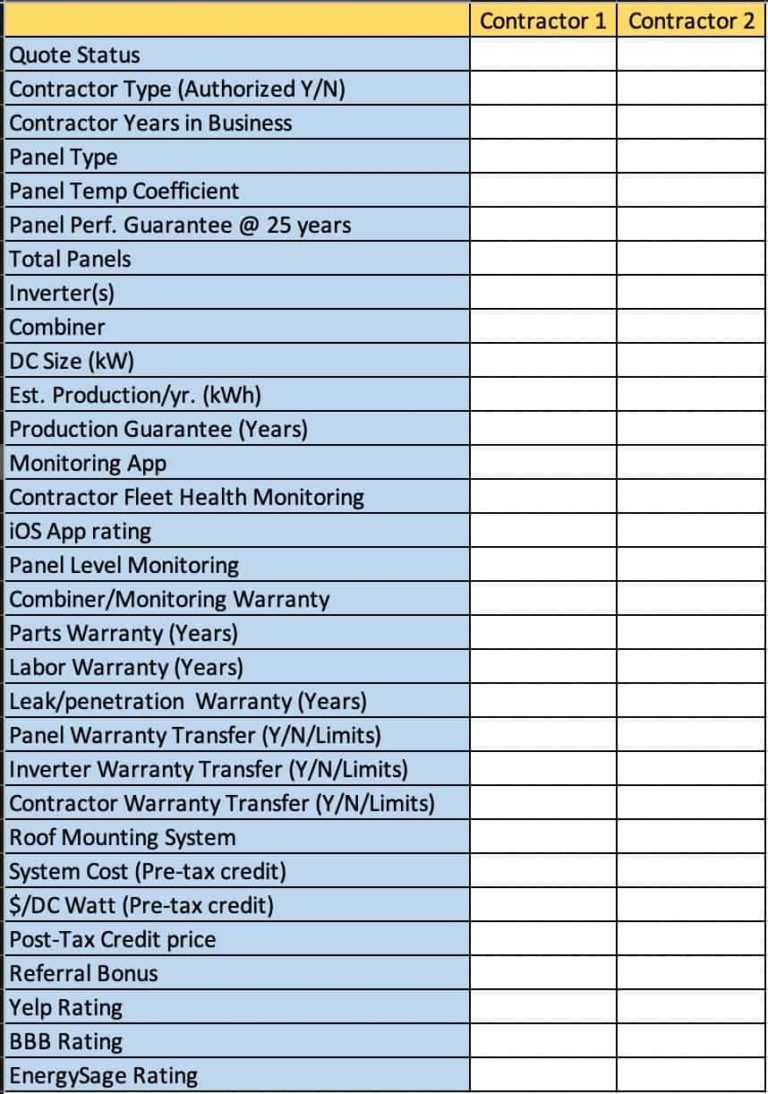
Summary
As you can see, evaluating solar options is complex and sometimes very frustrating. My advice is to go slow, read and re-read this post and let the technical details sink in. Then look up top Yelp/EnergySage reviewed solar only installers, invite a handful out to your house, interview them, get their proposals, then do final selection. Some vendors you can rule right out, due to the equipment they do or do not carry. For example, one contractor only used SolarEdge, which was a non-starter for me. Others were not authorized Panasonic dealers, so they were out of the running.
What did I go with? I got a 5.94 kWh system using 18x Panasonic N330E HIT AC series panels with Enphase IQ 7X microinverter. The system also came with the Enphase IQ Combiner 3 with IQ Envoy.
For a great Solar Energy FAQ, please check out the EnergySage FAQ here. Here’s also a great video from a San Diego homeowner about going solar.
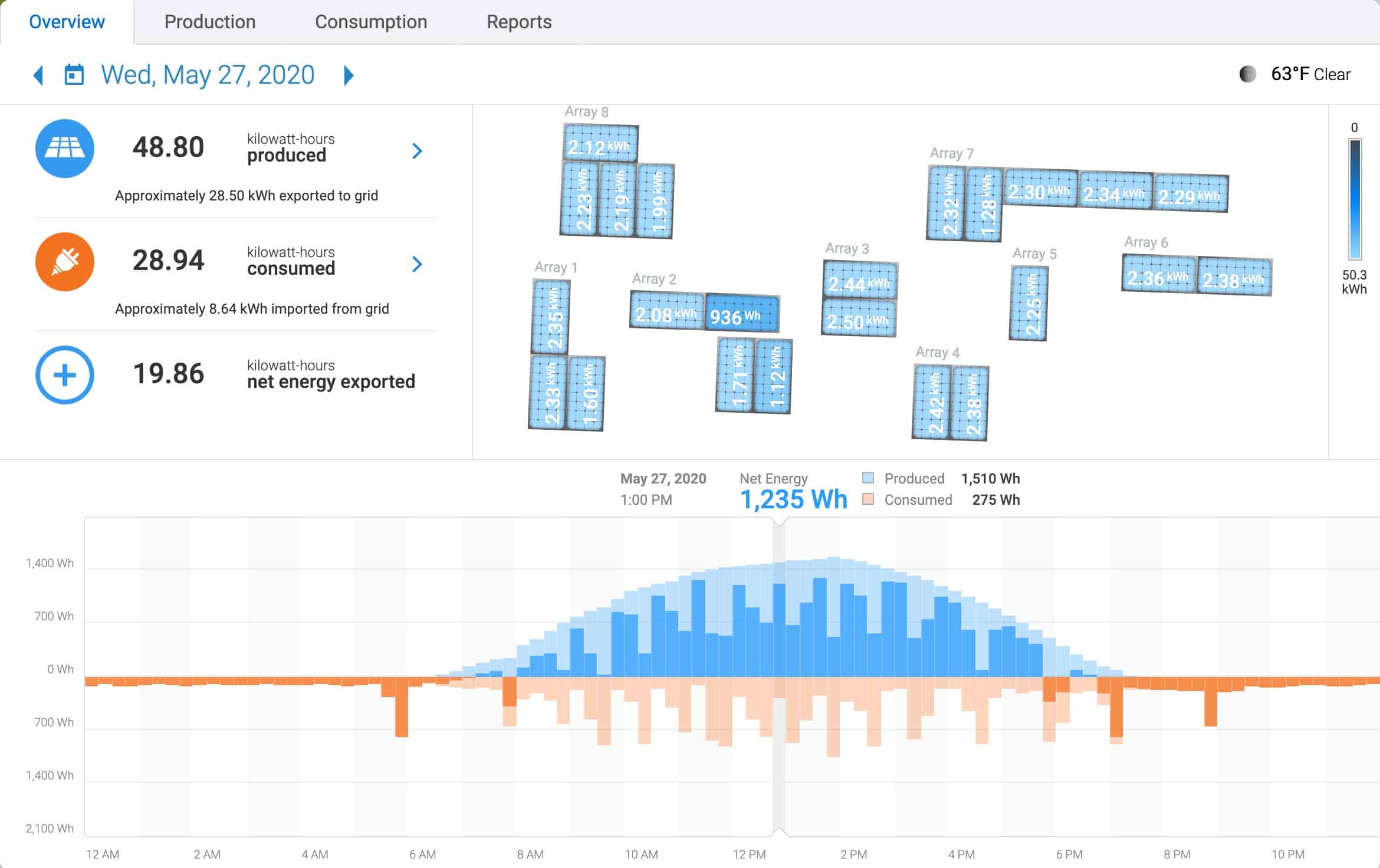
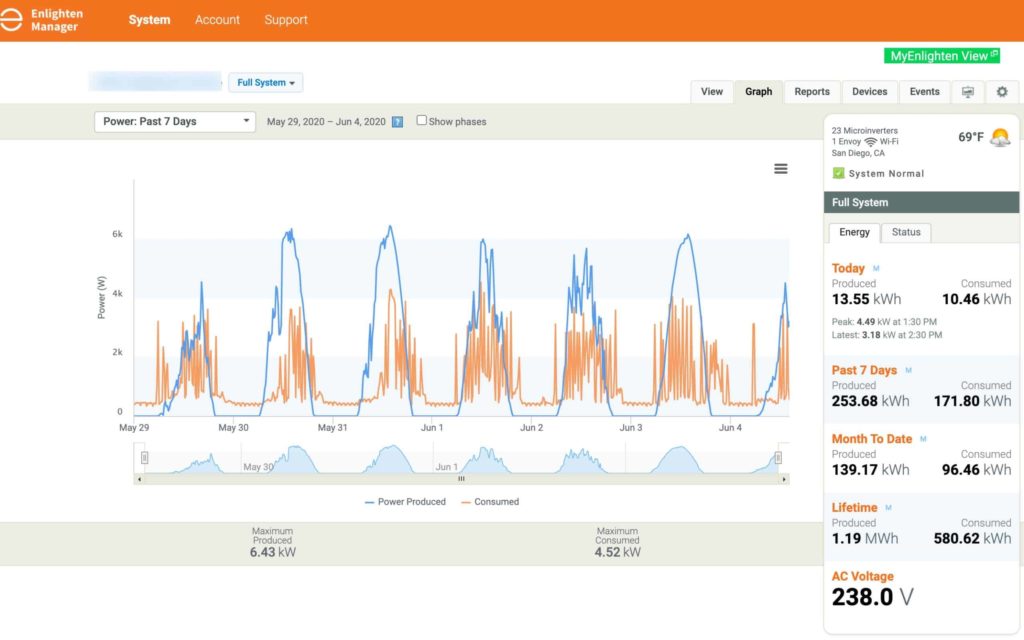





Another thing to think about with solar systems is an auxiliary battery system. IF you’re not getting a system with a battery (for usage at night and during low production periods), you’re still using power from whatever electric company is in the area. The electric companies lose a ton of cash from solar users, so they automatically put you in the highest billed tier plan to make up for the loss. SoCal Edison has a few plans to choose from, but the price/KwH is still absurd. Also, SoCal Edison switches you to an annual billing plan. The solar system is… Read more »
Very true! Batteries can be useful for time shifting your usage if your utility puts you on a TOU plan with a high cost differential.
Great write-up Derek. Very thorough and informative!
Thanks!